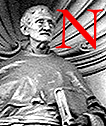 one of the six dark sonnets, such as "Carrion Comfort,"
contain the lush, dense, layered language so characteristic of ecstasy
poems such as "Pied Beauty", "The Windhover", and "God's Grandeur."
However, two poems — "Spelt from Sibyl's Leaves" and "That Nature is a
Heraclitean Fire and of the comfort of the Resurrection" — both bracket
the dark sonnets in time and reflect them in theme, exhibiting the rich
poetic diction that characterizes the earlier poems, e.g., the first line
of "Spelt from Sibyl's Leaves":
one of the six dark sonnets, such as "Carrion Comfort,"
contain the lush, dense, layered language so characteristic of ecstasy
poems such as "Pied Beauty", "The Windhover", and "God's Grandeur."
However, two poems — "Spelt from Sibyl's Leaves" and "That Nature is a
Heraclitean Fire and of the comfort of the Resurrection" — both bracket
the dark sonnets in time and reflect them in theme, exhibiting the rich
poetic diction that characterizes the earlier poems, e.g., the first line
of "Spelt from Sibyl's Leaves":
Earnest, earthless, equal, attuneable, ' vaulty, voluminous, ...
stupendous
Evening strains to be time's vast, ' womb-of-all, home-of-all,
hearse-of-all night.
and of "That Nature is a Heraclitean Fire and of the comfort of the Resurrection"
Cloud-puffball, torn tufts, tossed pillows ' flaunt forth, then chevy on
an air —
built thoroughfare: heaven-roysterers, in gay-gangs ' they throng; they
glitter in marches.
Each of these poems differ markedly from the ecstasy poems in their overall structure and in their specific tone and phrases, and from each other in their progressive mood, theme, and metaphor changes.
"Spelt from Sibyl's Leaves"
What does the title "Spelt from Sibyl's Leaves" mean in the context of the poem as a whole?
How does the first line of the poem foreshadow the tone of the poem.
"Earnest" seems a strange word, period, to have in this poem, and in particular to have as the first word in the poem and the first word in the sentence which uses words such as "vaulty" and "stupendous" to salute the majestic nature of evening. What does it contribute to the line and to the poem as a whole?
"Hornlight" refers to the horn sides of an old-fashioned lantern and "fond yellow hornlight" conveys a sense of warmth and affection. How does "wild hollow hoarlight" modify this mood? Does this trend continue?
How does the first part of the last, very long line relate to the last part?
Let life, waned, ah let life wind
Off her once skeined stained veined variety ' upon, all on two spools;
part, pen, pack
Now her all in two flocks, two folds-black, white; ' right, wrong; recon
but, reck but, mind
But these two; ware of a world where but these ' two tell, each off the
other;
of a rack
Where, selfwrung, selfstrung, sheathe — and shelterless, thoughts against
thoughts on groans grind.
With which of the dark sonnets does this last part most resonate?
The metaphors go from evening to earth to darkening light to waning life to conflicting opposites to the poet's mind. How does this progression, if one can call it that, foreshadow the dark sonnets?
Hopkins said about this sonnet:
Of this long sonnet above all remember what applies to all my verse, that it is, as living art should be, made for performance and that its performance is not reading with the eye but loud, leisurely, poetical (not rhetorical) recitation, with long rests, long dwells on the rhyme and other marked syllables, and so on. This sonnet should be almost sung: it is most carefully timed in tempo rubato.
How could you tell this just from reading it silently? Is this more or less true of this poem than of "That Nature is a Heraclitean Fire and of the comfort of the Resurrection"? Not surprisingly, this poem has been set to music.
"That Nature is a Heraclitean Fire and of the comfort of the Resurrection"
How is this poem an appropriate finale for the dark sonnet cycle, a cycle which may be said to have started with "Spelt from Sibyl's Leaves".
Heraclites' cosmology asserted change as the essence of reality, while a diamond is one of the least changeable of physical substances. What does the juxtaposition of these two apparent opposites mean, in the context of this poem and in the context of rest of Hopkins' poetry.
How is fire used in the poem, and how does its use change. Is there a relationship between change, fire, and diamond?
A diamond - beautiful, singular, hard, tool for carving other hard substances - results from eons of incredible pressure. How does the word 'immortal' modify diamond? Is Hopkins rejecting his intense sensuality and love of earth's beauty and variety?
Some people have read deep personal meaning into "That Nature is a Heraclitean Fire and of the comfort of the Resurrection" in the aftermath of 9/11. Do you agree or disagree?
Hopkins says this poem is a sonnet with two codas. Where does the sonnet part end? What are the two codas? Do you agree with this description? When does a modified sonnet cease to be a sonnet?
Comparison of the two poems
"Spelt from Sibyl's Leaves" and "That Nature is a Heraclitean Fire" in some ways remind me of a Wagner opera because of the leitmotifs that appeared earlier in Hopkins's work and now reappears: words like "dapple" — "her dapple is at an end" in "Spelt from Sibyl's Leaves" and "drowned" and "foundering" — "Across my foundering deck shone/A beacon" in "That Nature is a Heraclitean Fire."
What might Hopkins be trying to do by including these reminders?
Last modified 30 November 2003